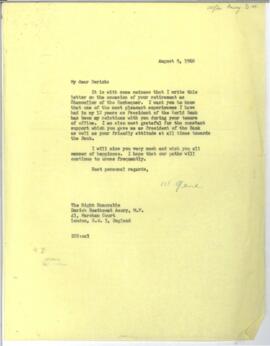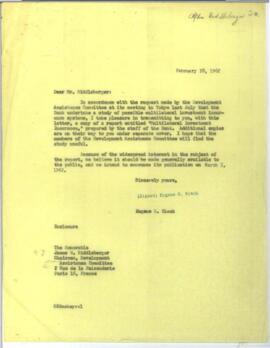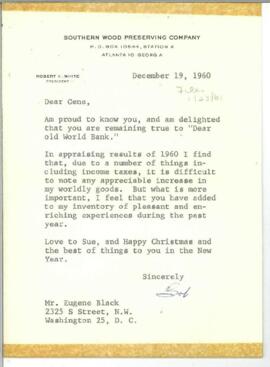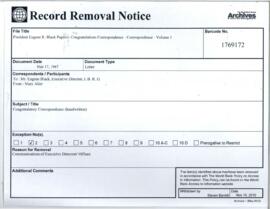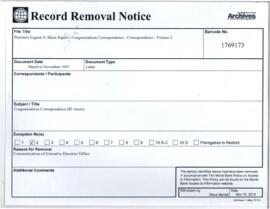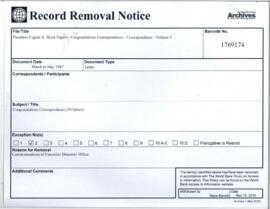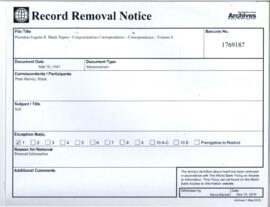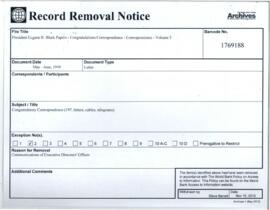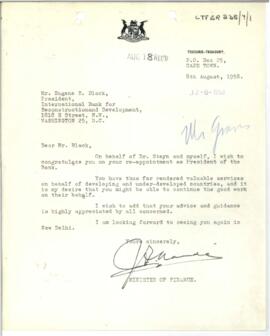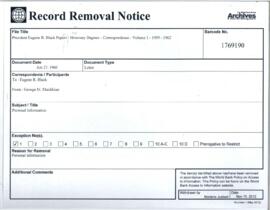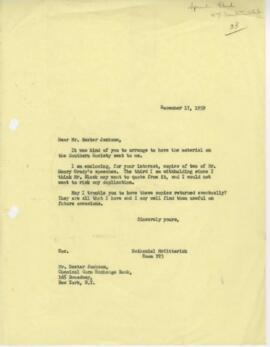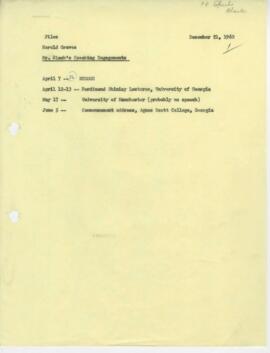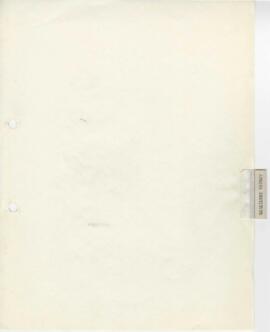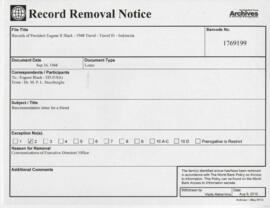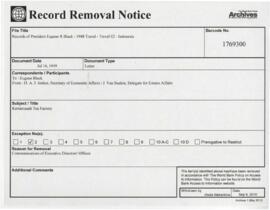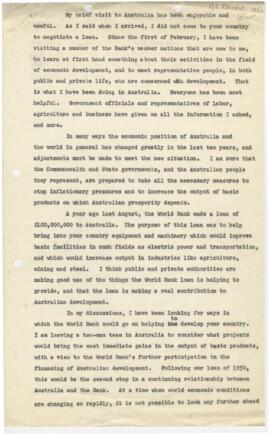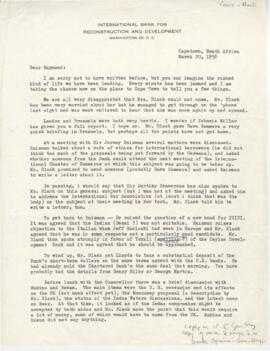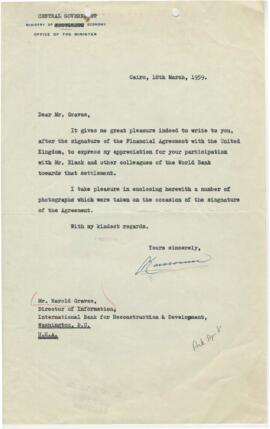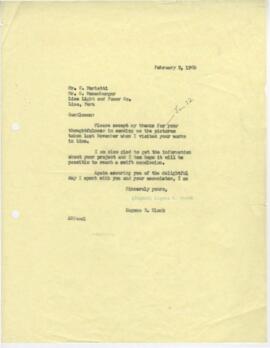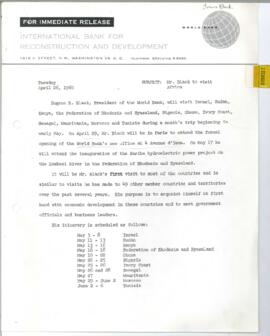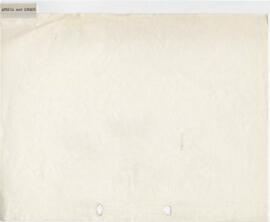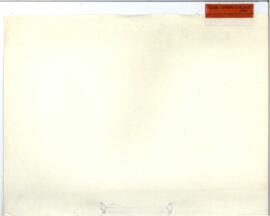Identity area
Reference code
Title
Date(s)
- 1947 - 1962 (Creation)
Level of description
Subfonds
Extent and medium
2.00 linear feet of textual records; 10 photographs
Context area
Name of creator
Biographical history
Eugene Robert Black (1898-1992) became President of the World Bank in July 1949. The Bank was still in its infancy, having opened its doors only three years previous. Its purpose was not yet widely known to the public nor, within the Bank was it completely determined. The Bank was still more focused on post-war reconstruction in Europe than the development of the poorer, post-colonial countries. Of the ten loans it had made prior to Black's presidency, eight were to the recovering countries in Western Europe. The Bank was a relatively modest institution in terms of its operations; while the two bond issues under Black's predecessor, John McCloy, were perceived as successful, they had only raised about $250 million.
Previous to his affiliation with the World Bank, Eugene R. Black (1898-1992) was an investment banker, employed primarily by the Chase National Bank in New York City. Prior to becoming Bank President, Black served two years as the United States Executive Director. Black's position as U.S. Executive Director was offered to him as part of the conditions placed by then incoming Bank President John J. McCloy. During his time as U.S. Executive Director, Black worked closely with McCloy while exploiting his extensive network of contacts to inform outsiders of the mission and processes of the Bank and to improve the institution's credit.
One of Black's first orders of business as Bank President was to further increase the Bank's credit and to expand its roster of available creditors. Until 1951, the Bank had raised funds exclusively in the United States. That year, however, the Bank made a bond offering on the London stock market, followed by another issue in the Netherlands in 1954. These and other bond issues were considered successful and it was not long before the Bank had established a reputation as a financially sound institution with an impeccable credit record.
The World Bank's transition from an institution initially focused primarily on lending for the reconstruction of Western European countries following the Second World War to one focused on the plight of developing countries took place primarily under Black's leadership. With this transition came a change in the types and objectives of Bank loans. The Bank's early loans to European countries were exclusively program loans which supported a variety of initiatives. With Black's encouragement, loans to developing countries were primarily project focused. The process of selecting projects for funding were based on an analysis of potential economic benefits. Black also emphasized a carefully prepared development plan for each country with funding provided for the projects of highest priority.
Black was known to be a masterful negotiator with strong skills in diplomacy and he used these qualities in the negotiation of financial disputes between a number of countries and their creditors. While the origin of Black and the Bank's role in the majority of these disputes arose from parties approaching the Bank for help, it was Black who approached Indiaand Pakistan in order to help resolve the issue of the allocation of water resources in the Indus Basin. Negotiations lasted nine years and led to a treaty between India and Pakistan. Black and Bank representatives also participated in negotiations related to claims made in the nationalization of the Suez Canal and the nationalization of the Iranian Oil Company.
In 1956, the Bank opened an affiliate organization to the International Bank for Reconstruction and Development (IBRD) that would support investment opportunities in private enterprise in developing countries. The new International Finance Corporation (IFC) was led by former IBRD Vice President Robert Garner. Black also oversaw the creation of another IBRD affiliate in 1961: the International Development Association (IDA). The IDA offered concessional financing featuring long-term low interest rate loans, thus making assistance available to all World Bank members regardless of their income level and debt-servicing capacity. In addition to increasing the number of World Bank clients, the creation of the IDA also led to a diversification of sector focus, as the Bank's lending scope grew to include agriculture, water, and education projects.
Black generally distanced himself from administrative responsibilities and the day-to-day operations of the Bank. His lone VP from 1949 to 1956, Robert Garner, oversaw the organization and operation of the Bank. After Garner left the position to become head of the IFC in 1956, Black named three new VPs: Davidson Sommers, who continued to serve as the Bank's General Counsel and was responsible for finance and fiscal operations and administrative matters; W. A. B. Iliff, who was assigned responsibility for relations with the member governments and the Executive Directors, liaison with international agencies, annual meetings programs and information programs, and the Economic Development Institute (EDI); and J. Burke Knapp, who supervised the operational departments, the Technical Operations Department (TOD) and economic research activities. During his time as Bank President, Black also relied heavily on assistants Richard Demuth and Harold Graves, who looked after public relations and wrote many of Black's speeches. While Bank staff increased substantially during Black's tenure, it was still small enough that senior managers could have regular access to the President.
The lone reorganization of Bank operations that occurred during Black's tenure showed his reliance on generalist-practitioners and project staff for decision making and project design rather than on the Bank's economists. Between 1946 and 1952, the Economic Department (ECD) which consisted primarily of economists, was responsible for functional and geographical analyses and maintained a degree of autonomy separate from Bank operations. The 1952 reorganization dissolved the ECD, moving country specialist staff into one of the three new Area Departments responsible for World Bank-member country relations. Sector-oriented staff of the ECD formed the new Technical Operations Department (TOD) and was placed in charge of project appraisal and supervision. This organizational structure implemented in 1952 was maintained for the next 20 years.
By the time Black left office in 1962, the Bank had raised over $4 billion through seventy-seven borrowing operations in the United States and Europe, and had more than doubled the number of staff. The Bank had funded 330 projects in 60 countries, and expanded its operational capabilities through the creation of the IFC and IDA and subsequently increased its clientele. And finally, the Bank was increasingly viewed by both world leaders and the financial community as an established, principled, and necessary institution.
Repository
Archival history
Other materials from the period of Eugene R. Black's service as President of the World Bank are with the Black papers in the Hargrett Library at the University of Georgia.
Immediate source of acquisition or transfer
Transferred from the Office of the President.
Content and structure area
Scope and content
This series contains the records of Eugene R. Black as U.S. Executive Director at the World Bank, 1947-1949, and President, 1949-1962. They are arranged in five file categories: general correspondence, congratulatory correspondence, honorary degrees, speeches, and travel.
The general correspondence file contains exchanges with U.S. and foreign government officials (especially U.K. officials), private bankers, lawyers, foundation officials and friends, arranged alphabetically by surname of correspondent. Among the notable correspondents are U.S. President Dwight Eisenhower, U.S. Senators J.W. Fulbright and Hubert Humphrey, British Prime Minister Harold McMillan, and U.N. Secretary General Dag Hammerskjold. The alphabetical correspondence file is followed by one file marked personal action covering the period from September through December 1960; it contains letters congratulating Black on the publication of his book, The Diplomacy of Economic Development, and wishing him recovery from surgery.
The congratulatory correspondence concerns Black's appointment as Executive Director and subsequent appointment and reappointments as President of the World Bank.
A single file contains correspondence on honorary degrees awarded to Black.
The speech file contains letters of invitation and appreciation and, in some cases, the texts of the speeches. Speeches given include commencement addresses, lectures to professional associations and private organizations, and addresses to the UN Economic and Social Council.
Thetravel file contains correspondence relating to tours Black took as U.S. Executive Director and as Bank President to familiarize himself with present and future member countries' economic and political situations and to meet national leaders. It includes letters of invitation, itineraries, thank you notes, as well as letters and memoranda on the purposes and results of particular trips. Two files contain the records of Black's 1948 trip to Indonesia (then the Netherlands East Indies) shortly before it obtained independence, including background material on Indonesia's economy and recent political developments, newspaper articles, UN documents, photographs, and letters from government officials, business executives and Black evaluating the situation in Indonesia. Other travel files contain information on the Bank's role in the settlement of the Suez Canal dispute (1958-1959).
Appraisal, destruction and scheduling
Accruals
Accruals are not expected.
System of arrangement
Records are arranged in five parts:
-
General correspondence
-
Congratulatory correspondence
-
Honorary degrees
-
Speeches
-
Tours [travel]
Conditions of access and use area
Conditions governing access
Records are subject to the World Bank Policy on Access to Information.
Conditions governing reproduction
Records are subject to the Copyright Policy of the World Bank Group.
Language of material
- English
Script of material
Language and script notes
Physical characteristics and technical requirements
Finding aids
Allied materials area
Existence and location of originals
Existence and location of copies
Related units of description
Notes area
Alternative identifier(s)
Access points
Subject access points
Place access points
Name access points
Genre access points
Description control area
Description identifier
Institution identifier
Rules and/or conventions used
Internal World Bank Group Archives rules based on ISAD(G).
Disclosure status
Level of detail
Dates of creation revision deletion
6 June 2006


